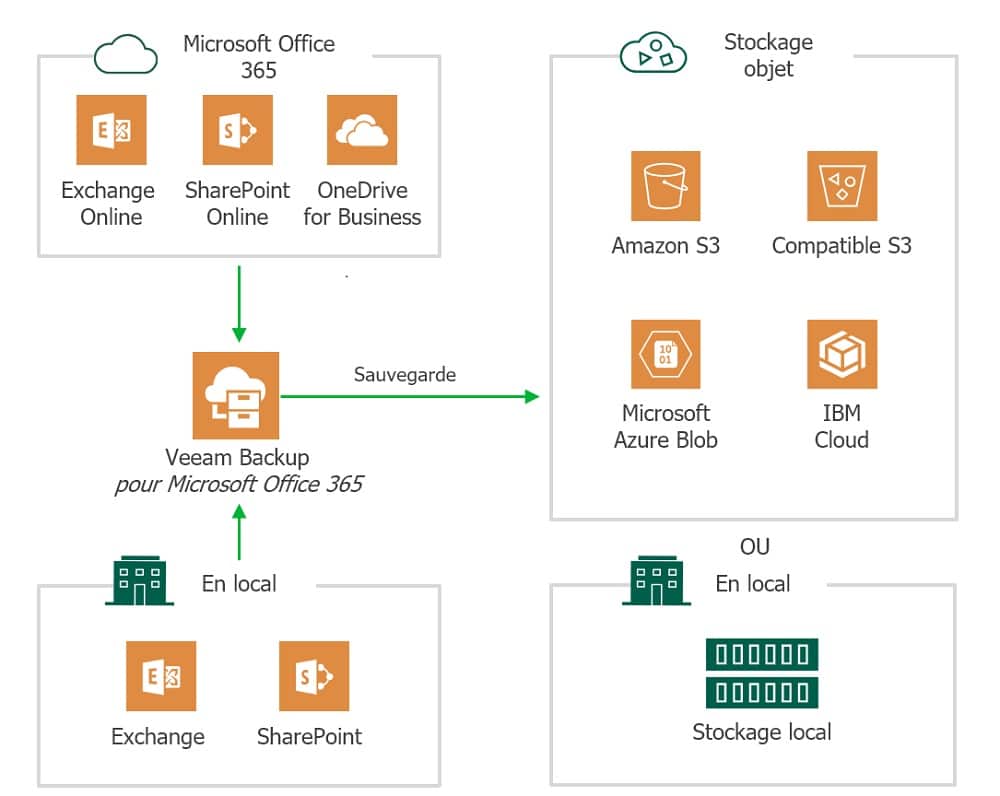Veeam Backup for Microsoft Office 365 can be installed in a single server setup for small environments or be scaled running on multiple servers to process bigger environments. The implementation design of Veeam Backup for Microsoft Office 365 is based on four different components within the product. Veeam Backup for Microsoft Office 365 Server. Veeam ® Backup for Microsoft Office 365 v4 allows for backup and recovery of Exchange, SharePoint, and OneDrive for Business data. Veeam ® Backup for Microsoft Office 365 v4 now supports cost-effective, S3-compatible cloud object storage and is validated for.
Backup & Recovery for Microsoft Office 365
Veeam Backup for Microsoft Office 365 is an all-inclusive remedy that allows you to back up and restore data from your Microsoft Office 365, on-premises Microsoft Exchange and on-premises Microsoft SharePoint organizations, including Microsoft OneDrive for Business.
Back up any data from Exchange Online, SharePoint Online and OneDrive for Business data weekly, daily or as often as every five minutes in any location of your choosing, on premises or in cloud object storage, that includes AWS S3, Azure Blob, IBM Cloud and S3-compatible providers. Always aim for reliability, granular restore of Office 365 email items, SharePoint sites, documents, libraries and lists, and OneDrive for Business accounts, files and folders, with a few clicks.
Protect your data

Veeam Backup for Microsoft Office 365, allows you to:
• Protect your Office 365 data from accidental deletion, security threats and retention policy gaps
• Quickly restore individual Office 365 items and files with industry-leading recovery flexibility
• Meet legal and compliance requirements with efficient eDiscovery of Office 365 backup items
Why backup Office 365?
Contrary to what most IT Pros believe, it is not Microsoft’s responsibility to protect your Office 365 data. Microsoft supplies a broad variety of powerful services within Office 365, however an all-inclusive backup of your Office 365 data is not one of them.
Veeam® Backup for Microsoft Office 365 does away with the risk of losing access and control over your Office 365 data including Exchange Online, SharePoint Online OneDrive for Business and Microsoft Teams, to ensure that your data is always safeguarded.
Back up Office 365 to any location - on premises or in the cloud
Bring back Office 365 Exchange Online, SharePoint Online, OneDrive for Business and Microsoft Teams data from a cloud-based Instance of Office 365 and originally back up your data weekly, daily or as often as every five minutes in Microsoft’s native format, which is an archive database focused on Extensible Storage Engine (ESE), also known as the Jet Blue database
- Back up Exchange and SharePoint on premises, reducing the impact to your data center while allowing YOU to set the frequency and timing of your backups
- Store backups in the location of your choice, including on premises, in a hyperscale public cloud (i.e., Microsoft Azure or Amazon Web Services) or with a local service provider
- Protect data posted and shared with Microsoft Teams chats, files and sites, as Teams data is journaled into Exchange Online and SharePoint Online

Restore Office 365 with industry-leading recovery flexibility
Always aim for reliability of, granular restore of Office 365 email items, SharePoint sites, documents, libraries and lists, as well as OneDrive for Business accounts, files and folders in a few simple clicks:
- Quick search and granular recovery of individual objects which includes Microsoft Teams data, residing in a protected copy of your Office 365 backup.
- Direct restore of Office 365 items through an industry-leading number of ways, giving you the ultimate restore flexibility.
eDiscovery of Office 365 data
Without an easily retrievable copy of your data, bringing back emails for regulatory or compliance purposes may turn out to be costly, time-consuming and a big distraction to your business.
With Veeam, you can leverage the familiar advanced search features as well as the flexible recovery and export options to carry out eDiscovery on Office 365 data, with the same ease as a traditional on-premises data backup.

Our Business Team are always available to answer any of your questions. Please feel free to submit any requests by email or through the contact form below.
Short Description
Removes an organization entity data from a repository.
Syntax
This cmdlet provides the following parameter sets:
- Remove organization user data.
Remove-VBOEntityData -Repository <VBORepository> -User <VBOUserData> [-Mailbox] [-ArchiveMailbox] [-OneDrive] [-Sites] [-WhatIf] [-Confirm] [<CommonParameters>] |
- Remove organization group data.
Remove-VBOEntityData -Repository <VBORepository> -Group <VBOGroupData> [-Mailbox [<SwitchParameter>]] [-ArchiveMailbox [<SwitchParameter>]] [-OneDrive [<SwitchParameter>]] [-Sites [<SwitchParameter>]] [-GroupMailbox [<SwitchParameter>]] [-GroupSite [<SwitchParameter>]] [-RunAsync [<SwitchParameter>]] [-WhatIf [<SwitchParameter>]] [-Confirm [<SwitchParameter>]] [<CommonParameters>] |
- Remove organization site data.
Remove-VBOEntityData -Repository <VBORepository> -Site <VBOSiteData> [-RunAsync [<SwitchParameter>]] [-WhatIf [<SwitchParameter>]] [-Confirm [<SwitchParameter>]] [<CommonParameters>] |
- Remove organization team data.
Remove-VBOEntityData -Repository <VBORepository> -Team <VBOTeamData> [-RunAsync [<SwitchParameter>]] [-WhatIf [<SwitchParameter>]] [-Confirm [<SwitchParameter>]] [<CommonParameters>] |
Detailed Description
This cmdlet allows to remove the organization entities data.
Parameters
Parameter | Description | Required | Position | Accept Pipeline Input | Accept Wildcard Characters |
|---|---|---|---|---|---|
Repository | Specifies the location of the entity backed-up data. | True | Named | False | False |
User | Specifies the organization user entity. | True | Named | True (ByValue) | False |
Mailbox | Indicates that this cmdlet will remove the entity mailbox data. | False | Named | False | False |
ArchiveMailbox | Indicates that this cmdlet will remove the entity archive mailbox data. | False | Named | False | False |
OneDrive | Indicates that this cmdlet will remove the entity OneDrive data. | False | Named | False | False |
Sites | Indicates that this cmdlet will remove the entity sites data. | False | Named | False | False |
RunAsync | Indicates that the command returns immediately without waiting for the task to complete. | False | Named | False | False |
WhatIf | Specifies whether the cmdlet writes a message that describes the effects of running the cmdlet without actually performing any action. | False | Named | False | False |
Confirm | Specifies whether the cmdlet displays a prompt that asks if the user is sure that they want to continue. | False | Named | False | False |
Group | Specifies the organization group entity. | True | Named | True (ByValue) | False |
GroupMailbox | Indicates that this cmdlet will remove the organization group mailbox data. | False | Named | False | False |
GroupSite | Indicates that this cmdlet will remove the organization group site data. | False | Named | False | False |
Site | Specifies the organization site entity. | True | Named | True (ByValue) | False |
Team | Specifies the organization team entity. | True | Named | True (ByValue) | False |
<CommonParameters>
This cmdlet supports Microsoft PowerShell common parameters. For more information on common parameters, see the About CommonParameters section of Microsoft Docs.
Examples
Example 1
This example shows how to remove data of a user with the name 'Chuck Brown'.
- Run the Get-VBORepository cmdlet with the Name parameter to get the repository. Save the result to the $repository variable.
- Run the Get-VBOEntityData cmdlet with the Name parameter and a $repository variable. Save result to the $user variable.
- Run the Remove-VBOEntityData cmdlet with the $repository and $user variables and Mailbox, ArchiveMailbox, OneDrive and Sites parameters to remove the data.
$repository = Get-VBORepository -Name 'ABC Daily Backup' $user = Get-VBOEntityData -Type User -Repository $repository -Name 'Chuck Brown' Remove-VBOEntityData -Repository $repository -User $user -Mailbox -ArchiveMailbox -OneDrive -Sites |
Example 2
This example shows how to remove data of an organization group with the name 'support'.
- Run the Get-VBORepository cmdlet with the Name parameter to get the source repository. Save the result to the $repository variable.
- Run the Get-VBOEntityData cmdlet with the Name parameter and a $repository variable. Save result to the $group variable.
- Run the Remove-VBOEntityData cmdlet with the $repository and $group variables and Mailbox, ArchiveMailbox, OneDrive, Sites, GroupMailbox and GroupSite parameters to remove the data.
Veeam 365 Setup
$repository = Get-VBORepository -Name 'ABC Daily Backup' $group = Get-VBOEntityData -Type Group -Repository $repository -Name 'support' Remove-VBOEntityData -Repository $repository -Group $group -Mailbox -ArchiveMailbox -OneDrive -Sites -GroupMailbox -GroupSite |
Example 3
This example shows how to remove data of an organization site with the name 'support'.

Veeam For Office 365

- Run the Get-VBORepository cmdlet with the Name parameter to get the source repository. Save the result to the $repository variable.
- Run the Get-VBOEntityData cmdlet with the Name parameter and a $repository variable. Save result to the $site variable.
- Run the Remove-VBOEntityData cmdlet with the $repository and $site variables to remove the data.
$repository = Get-VBORepository -Name 'ABC Daily Backup' $site = Get-VBOEntityData -Type Site -Repository $repository -Name 'support' Remove-VBOEntityData -Repository $repository -Site $site |
Related Commands
